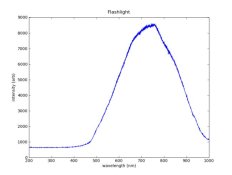michaelbsc
Member
Hey guys, I need to make some color copies of a few things, and I'm beginning to talk my self out of using the now prolific "daylight" 5000K compact fluorescent bulbs that I see everywhere. Normally I don't care about getting the color "right" but this time I do.
Here's my thinking, and if someone can either confirm that I'm right or point out that I'm out to lunch I would appreciate it.
Almost everything I do is B&W, and the few occasions I do drag out and put up a copy stand I use the CF curly bulbs. They work great and don't heat up my smallish place too much. But some of the family want copies of some departed parents and grandparents, so I'm going to make color negatives.
Now, my question is that all the color film I have is daylight, and my CF bulbs are "daylight" bulbs as well. But thinking about how fluorescent bulbs work, i.e. stimulated electron decay from a specific material, I get the distinct impression that the color spectrum might "look like daylight" to the eye, but might not look all that close to daylight to a piece of film. Specifically, I can imagine that the CF bulbs have giant gaps in the spectral coverage, gaps that a hot glowing tungsten filament would not have.
Obviously, I care about the color for these particular pictures far more than I do about most of the stuff I shoot. Usually I just stick in the film and let it go, and no one complains about the color balance, they're just happy to have the pictures. But I want these to be as right as I can get without spending a fortune.
So, will the CF bulbs really do the trick with daylight film, or should I spring for a brick of real tungsten film?
Somewhere I've got a couple of old movie camera light bars with the massive photo-flood lamps on them. Should I dig that out, too? Or will regular grocery store bulbs work? If I should use the light bars, I know some of the lamps are dead, so what lamps should I use to get as close to tungsten film without filters as possible?
And I have seen some really, seriously blue incandescent bulbs at a camera shop about an hour from here. My assumption was that these are "daylight" tungsten bulbs. Will those work with the daylight film I have? Or do they cost more than tungsten film?
What's the best "dedicated enthusiast" way to do this vs. the prohibitively expensive professional way. (I know, some wag is going to say take them in the back yard and use real daylight. But let's be realistic.)
Thanks,
Michael
Here's my thinking, and if someone can either confirm that I'm right or point out that I'm out to lunch I would appreciate it.
Almost everything I do is B&W, and the few occasions I do drag out and put up a copy stand I use the CF curly bulbs. They work great and don't heat up my smallish place too much. But some of the family want copies of some departed parents and grandparents, so I'm going to make color negatives.
Now, my question is that all the color film I have is daylight, and my CF bulbs are "daylight" bulbs as well. But thinking about how fluorescent bulbs work, i.e. stimulated electron decay from a specific material, I get the distinct impression that the color spectrum might "look like daylight" to the eye, but might not look all that close to daylight to a piece of film. Specifically, I can imagine that the CF bulbs have giant gaps in the spectral coverage, gaps that a hot glowing tungsten filament would not have.
Obviously, I care about the color for these particular pictures far more than I do about most of the stuff I shoot. Usually I just stick in the film and let it go, and no one complains about the color balance, they're just happy to have the pictures. But I want these to be as right as I can get without spending a fortune.
So, will the CF bulbs really do the trick with daylight film, or should I spring for a brick of real tungsten film?
Somewhere I've got a couple of old movie camera light bars with the massive photo-flood lamps on them. Should I dig that out, too? Or will regular grocery store bulbs work? If I should use the light bars, I know some of the lamps are dead, so what lamps should I use to get as close to tungsten film without filters as possible?
And I have seen some really, seriously blue incandescent bulbs at a camera shop about an hour from here. My assumption was that these are "daylight" tungsten bulbs. Will those work with the daylight film I have? Or do they cost more than tungsten film?
What's the best "dedicated enthusiast" way to do this vs. the prohibitively expensive professional way. (I know, some wag is going to say take them in the back yard and use real daylight. But let's be realistic.)
Thanks,
Michael












